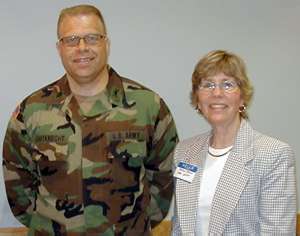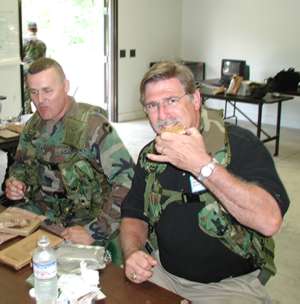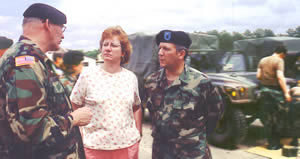 |
Shortly before his unit's deployment to Bosnia, Kevin Gutknecht, Metro
District public affairs coordinator and an officer in the National Guard,
met with his supervisor, Betsy Brown, the district's director of Business
Operations and Services. Photo courtesy of National Guard
|
Mn/DOT earned recognition for its support of employees in service with the
National Guard and Reserve forces from the state’s Department of Military Affairs
during Employer Day activities at Camp Ripley on June 24.
Mike Olson, business manager, Finance and Administration, accepted the award
for Mn/DOT’s Central Office. Olson serves as a chief warrant officer with the
Guard’s 34th Division Support Command.
Mike Robinson, district engineer at Duluth, also visited Camp Ripley to accept
the award for the district’s support of its employees in military service. Robinson
accompanied Jody Gunlock, a management analyst at Duluth now on active duty
with the National Guard.
The department was one of 500 Minnesota employers honored for their commitment
to employees in military service. Statewide, about 18,500 people serve in Guard
and Reserve units.
More than 80 Mn/DOT employees are in military service
 |
At left is Jody Gunlock, Duluth/District 1, a major with the Minnesota
National Guard, participates in a training mission at Camp Ripley. He’s
pictured with Mike Robinson, district engineer at Duluth. Photo courtesy
of John Bray.
|
Gunlock, a management analyst at Duluth, is serving his second active duty
tour as a Guard officer. He served in Croatia from April 2000 until March 2001
and will return to peacekeeping duties in the region this month when his unit,
the 2nd Battalion of the 136th Infantry, deploys to Bosnia.
Gunlock said his military experience in planning, staffing and leadership have
benefited him and his career with Mn/DOT.
"My experience and training is easily transferable to my work at Mn/DOT,"
he said, "and the district has been very supportive during my active duty
tours."
The Army and Air National Guard units have dual roles. They serve their respective
states in case of domestic emergencies or natural disasters and can be federalized
to support the country’s military missions. Reserve forces provide combat-ready
forces for various branches of the military.
Current Minnesota National Guard assignments include providing security at
two U. S. Air Force bases in Minnesota and preparing Guard units for deployment
for extended duty in Bosnia and Kosovo.
More than 80 Mn/DOT employees serve in National Guard or Reserve forces.
State agencies, Olson said, grant employees 15 days of paid military leave
In addition, the 2003 Legislature passed a law requiring the state to make
up the difference if employees’ military pay is less than their regular salary
when serving on active duty.
Eric Davis, Office of Workforce Development, an officer in the Air Force Reserve,
is assigned with to the Employer Support of the Guard and Reserve national headquarters
in Washington, D. C. ESGR recognizes the efforts made by Mn/DOT, other state
agencies and the Pawlenty Administration to create a supportive culture for
members of the military and their families.
Davis served on active duty at the Pentagon briefly during the war in Iraq.
His duties included mediating conflicts between Guard and Reserve members called
to active duty and their employers.
"Since Sept. 11, it’s been easier to get employers to do the right thing,"
he said. "We need to build a culture that makes the work force friendly
to those who volunteer for military service and bring honor to our nation."
Employer support "crucial" to maintaining military force
 |
Col. Gerald Lang briefs Lucy Kender, director, Office of Communications,
and Mike Olson, business manager, Finance and Administration, during
their Employer Day visit to Camp Ripley. Photo by Craig Wilkins
|
According to the Minnesota National Guard’s Col. Gerald Lang, the states provide
50 percent of the staffing needs of the major military branches, whether they
are providing security at airports and other facilities or serving in places
such as Afghanistan, Bosnia, Kosovo or Iraq.
Lang, who leads the 34th Division’s Support Command based in Bloomington, said
employer support is crucial to maintaining a citizen-soldier military force.
During a briefing at Camp Ripley, Lang cited Guard and Reserve forces comprise
an integral part of the national defense effort.
Lang cited the contributions of Minnesota’s volunteer citizen-soldiers, from
the First Minnesota Regiment, the first unit to volunteer for service in the
Civil War, to the current campaign in Iraq and peacekeeping missions in places
such as Bosnia and Kosovo.
The impact of Mn/DOT’s contribution shows in the number of employees now on
active duty or who have recently completed active duty tours.
In one instance, four employees from the Metro District serve in the same squadron
of the Air Force Reserve’s 934th Airlift Wing based at the Minneapolis-St. Paul
International Airport. Three more Mn/DOT employees from the Mankato District
serve with them in the wing’s 934th Civil Engineering Squadron.
Stan Thompson, a Metro project engineer and an engineering officer with the
squadron, said their Mn/DOT experience and their military duties are complementary.
"We provide expertise in areas such as plumbing, carpentry, surveying
and running heavy equipment while acquiring new skills that enhance our Mn/DOT
careers," he said.
Bob Eddy, an information technology specialist with Willmar/District 8, has
been a member of the Minnesota National Guard for 36 of his 37 years with Mn/DOT.
Eddy currently serves as the first sergeant with the Guard’s 84th Troop Command
in Roseville.
Eddy said the department’s support of his role with the Guard has been constant.
"There’s never been a question about my being able to meet my service
obligation," he said.
Ron Gipp, director of the Audit Section, said his staff adapted well to cover
for auditor Gary Morr, an Air National Guard member who just returned from four
months’ active duty at Scott Air Force Base in Illinois.
"We reassigned people to share Gary’s responsibilities; the Air Force
needed financial experts and Gary’s assignment made it possible for regular
Air Force staff to serve in Iraq where they were most needed," Gipp said.
By Craig Wilkins
|



